
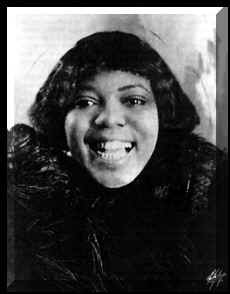
Beginnings
| Talent and Troubles
| The Harlem Renaissance and Her
Legacy| Analysis
of "Down Hearted Blues"|
Links
| Works
Cited

BEGINNINGS
“Bessie Smith was a rough, crude, violent woman” (BS 1). Yet it was this
woman who helped create the fusion of southern blues and northern jazz during
the time period known as the Harlem Renaissance. Although the actual date is
unknown, Smith was born sometime around 1898 in Chattanooga, Tennessee. Her
singing career began early with her first public appearance at age nine,
performing mainly gospel and spiritual songs. It was not until she joined the
“Rabbit Foot Minstrels”, a traveling performance group, that she was exposed
to the blossoming genre of the blues. Traversing the south with the
“classic” blues singer ‘Ma’ Rainey, Smith learned the in’s and out’s
of show business and prepared herself for the career to which she would dedicate
herself for the rest of her life (Hadlock 219). Progressing to the vaudeville
stage, Smith’s popularity grew tremendously throughout the early 1920’s, yet
she was still mainly unknown to the general public.
Back
To Top

TALENT
AND TROUBLES
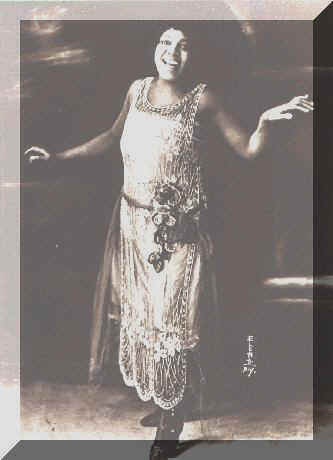 In 1923, she recorded the
first of her studio sessions for Columbia Records, laying down the tracks
“Gulf Coast Blues” and “Down Hearted Blues”, thus beginning her rise to
fame (BS 1). Her style was described as “earthy”, and steeped in the bluesy
traditions of her mentor. “Bessie’s winning style, made beautiful by a
sonorous, deep-chested but perfectly controlled voice, came straight from Ma
Rainey” (Hadlock 219). With her acclaim and successes came hardships and
abuse, however, yet they were troubles to which Smith responded to explosively.
She was known for her short temper and belligerent personality, often not beyond
attempting murder when consumed in a rage. On one occasion, Smith took several
shots at her adulterous husband with his own handgun after discovering his
affair with one of her chorus girls, only after picking up and throwing the girl
in question from a train. Interestingly enough, it was common knowledge that
Smith herself was frequently engaged in some type of relationship with one of
her chorus girls, yet always unpublicized for fear of damaging record sales
(Reflections 1).
In 1923, she recorded the
first of her studio sessions for Columbia Records, laying down the tracks
“Gulf Coast Blues” and “Down Hearted Blues”, thus beginning her rise to
fame (BS 1). Her style was described as “earthy”, and steeped in the bluesy
traditions of her mentor. “Bessie’s winning style, made beautiful by a
sonorous, deep-chested but perfectly controlled voice, came straight from Ma
Rainey” (Hadlock 219). With her acclaim and successes came hardships and
abuse, however, yet they were troubles to which Smith responded to explosively.
She was known for her short temper and belligerent personality, often not beyond
attempting murder when consumed in a rage. On one occasion, Smith took several
shots at her adulterous husband with his own handgun after discovering his
affair with one of her chorus girls, only after picking up and throwing the girl
in question from a train. Interestingly enough, it was common knowledge that
Smith herself was frequently engaged in some type of relationship with one of
her chorus girls, yet always unpublicized for fear of damaging record sales
(Reflections 1).
Back
To Top

THE
HARLEM RENAISSANCE AND HER LEGACY
Her record sales did not fail, however, and Smith forged ahead
in bridging the gap between blues and jazz. Her strong, bluesy voice carried
beautifully over the jazzy arrangements written by her New York musicians, often
men working just to sustain themselves (Hadlock 236). They were the musical
engines of the Harlem Renaissance, driving the new African-American sound of
jazz to the public through clubs and bars condensed within the New York area.
Smith pounced on their groundbreaking sound and infused it with her southern
blues style, thus bringing the blues, and subsequently jazz, into the mainstream
of 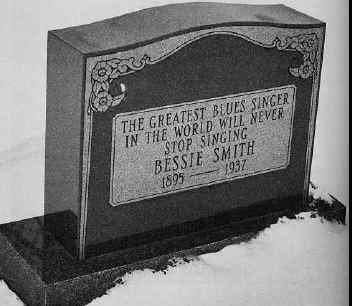 American culture. Bessie Smith’s death was a slow and tragic one, and the
life of one of America’s most important musical contributors was cut short one
fall evening in 1936. Badly wounded in a car accident in Mississippi, Smith bled
to death en route to a “black” hospital despite the relative proximity of a
hospital reserved for whites (BS 2). Her “magnificent voice and direct
approach to the blues left their mark on almost every singer…who ever heard
her in person or on records”, and remains one of the defining voices of the
Harlem Renaissance (Hadlock 236).
American culture. Bessie Smith’s death was a slow and tragic one, and the
life of one of America’s most important musical contributors was cut short one
fall evening in 1936. Badly wounded in a car accident in Mississippi, Smith bled
to death en route to a “black” hospital despite the relative proximity of a
hospital reserved for whites (BS 2). Her “magnificent voice and direct
approach to the blues left their mark on almost every singer…who ever heard
her in person or on records”, and remains one of the defining voices of the
Harlem Renaissance (Hadlock 236).
Back
To Top

ANALYSIS
OF "DOWNHEARTED BLUES"
“Downhearted Blues” is one of the
earliest and most definitive songs of Bessie Smith’s career, displaying both
her power and soulful musical presence. Her voice is almost haunting, filling
every moment of the song; even when she is not singing it echoes in the mind of
the listener. “Downhearted Blues” never seems empty or thin even though she
is accompanied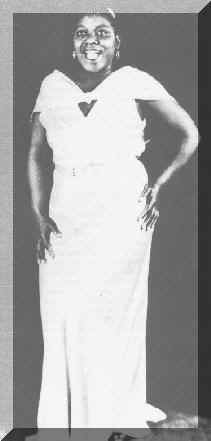 solely by the pianist Clarence Williams. “A pedestrian pianist,
he appears to have played scarcely a note beyond those written on the sheet
music before him, but that does not keep Bessie from giving a superb, definitive
reading of the song” (Albertson 30). Although it was her first experience in a
recording studio, Smith exhibits only assurance and confidence, letting her
voice transcend to an almost inhuman level. The basic structure of the song is
simple and repetitive, a common trademark of the blues. Melody is carried by
Smith’s tremendous voice, while the piano sets a solid, almost percussive
foundation of harmony. Although the scales are undeniably blues scales, Smith
swings in and out of the beat in a syncopated groove that can only be described
as jazz. Like nowhere else is the fusion of jazz and blues more present than in
“Downhearted Blues”, in everything from the tone of Williams’ piano to the
robust but seductive strength in Smith’s voice. “Bessie delivers the song
with authority and just the right amount of pathos; even when she is pouring out
her woes it is with an edge of magnificent defiance” (Albertson 30). It is
this “magnificent defiance” that made Bessie Smith the indelible character
of the Harlem Renaissance that she was, and “Downhearted Blues” the
momentous recording it was remembered as.
solely by the pianist Clarence Williams. “A pedestrian pianist,
he appears to have played scarcely a note beyond those written on the sheet
music before him, but that does not keep Bessie from giving a superb, definitive
reading of the song” (Albertson 30). Although it was her first experience in a
recording studio, Smith exhibits only assurance and confidence, letting her
voice transcend to an almost inhuman level. The basic structure of the song is
simple and repetitive, a common trademark of the blues. Melody is carried by
Smith’s tremendous voice, while the piano sets a solid, almost percussive
foundation of harmony. Although the scales are undeniably blues scales, Smith
swings in and out of the beat in a syncopated groove that can only be described
as jazz. Like nowhere else is the fusion of jazz and blues more present than in
“Downhearted Blues”, in everything from the tone of Williams’ piano to the
robust but seductive strength in Smith’s voice. “Bessie delivers the song
with authority and just the right amount of pathos; even when she is pouring out
her woes it is with an edge of magnificent defiance” (Albertson 30). It is
this “magnificent defiance” that made Bessie Smith the indelible character
of the Harlem Renaissance that she was, and “Downhearted Blues” the
momentous recording it was remembered as.
Back
To Top

LINKS
Bessie
Smith - All Music Guide
Bessie
Smith Bio from "Jazz - A Film by Ken Burns"
Sample
Bessie Smith Music and More @ Artist Direct
Red
Hot Jazz
Learn
More about the Harlem Renaissance!
Back To Top

WORKS
CITED
Albertson,
Chris. Bessie Smith: Biography and Notes on the Music. USA: Time Life
Books, 1982.
“Bessie
Smith” (1). http://www.redhotjazz.com/bessie.html
17 Jan 2003
“Bessie
Smith” (2). http://www.uic.edu/depts/quic/history/bessie_smith.html
17 Jan 2003
Hadlock,
Richard. Jazz Masters of the 20’s. New York, NY: The Macmillion
Company, 1965.
“Reflections
of 1920’s and 30’s Street Life In The Music Of Bessie Smith”
http://www.blusnet.hub.org/readings/bessie.html
17 Jan 2003
Back To Top

Thanks For Visiting
My Site
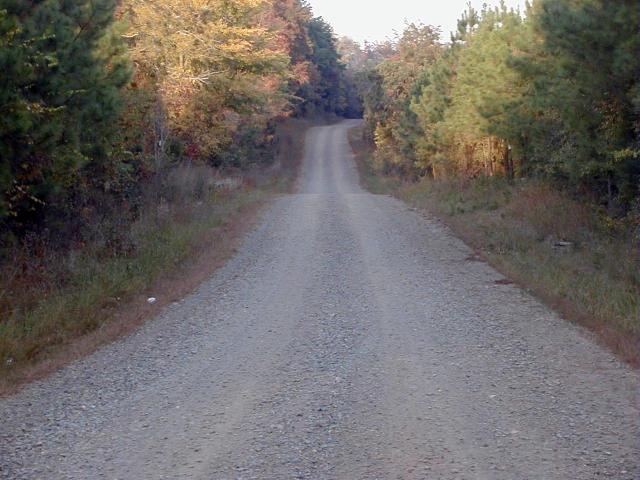
[Hit Counter]
people have visited this site
-


![]()
![]()
